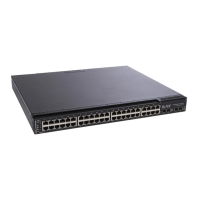© Copyright IBM Corp. 2011 Chapter 26. Link Layer Discovery Protocol 315
By default, all optional LLDP information types are included in LLDP transmissions.
LLDP Receive Features
Types of Information Received
When the LLDP receive option is enabled on a port (see “Enabling or Disabling
LLDP” on page 311), the port may receive the following information from
LLDP-capable remote systems:
• Chassis Information
• Port Information
• LLDP Time-to-Live
• Port Description
• System Name
• System Description
• System Capabilities Supported/Enabled
• Remote Management Address
The G8000 stores the collected LLDP information in the MIB. Each remote
LLDP-capable device is responsible for transmitting regular LLDP updates. If the
received updates contain LLDP information changes (to port state, configuration,
LLDP MIB structures, deletion), the switch will set a change flag within the MIB for
convenient notification to SNMP-based management systems.
Viewing Remote Device Information
LLDP information collected from neighboring systems can be viewed in numerous
ways:
• Using a centrally-connected LLDP analysis server
• Using an SNMP agent to examine the G8000 MIB
• Using the G8000 Browser-Based Interface (BBI)
• Using CLI or isCLI commands on the G8000
portprot
IEEE 802.1 Port and Protocol VLAN ID
vlanname
IEEE 802.1 VLAN Name
protid
IEEE 802.1 Protocol Identity
macphy
IEEE 802.3 MAC/PHY Configuration/Status, including the
auto-negotiation, duplex, and speed status of the port.
powermdi
IEEE 802.3 Power via MDI, indicating the capabilities and
status of devices that require or provide power over
twisted-pair copper links.
linkaggr
IEEE 802.3 Link Aggregation status for the port.
framesz
IEEE 802.3 Maximum Frame Size for the port.
all
Select all optional LLDP information for inclusion or exclusion.
Table 24. LLDP Optional Information Types (continued)
Type Description

